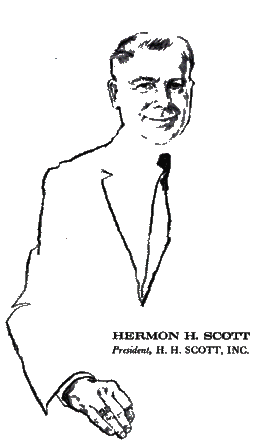


Reading
Room
Thermionic
Audio Books
Last Edited:
31-Jan-2002
| |
Reprinted from circa, "1959 - 1960":
|

|
They Shall
Have Music
|
By John M. Conly
|
The Scott Hypothesis
|
Boston is bordered on the west by electronics. Belting the
city, across the route once ridden by Paul Revere and his daring companions, is a
string of bright new buildings, mostly single-storied and imaginatively tinted.
They represent the Yankee challenge in modern industry and reflect the research
constantly in progress at Harvard, M.I.T., and other great New England schools,
together with the incomparable skilled labor this has brought into being. Not
least impressive of the buildings is a structure identified, with admirable
simplicity, as H.H. Scott, which house, during work hours, more than three hundred
people, and its product is reproduced sound, pure as it can be.
|

|
Hermon Hosmer Scott is a soft-spoken, middle-sized man, with
a down-East accent to which he is entitled. One of his forebears was a adjunct to
a militia detachment which made itself famous at Concord on April 19, 1775. He
still lives in the neighborhood, near Maynard, with his wife Eleanor, and two
daughters, Priscilla and Jane.
It would be downright silly to introduce H.H. Scott to
veteran record listeners. We have been gratefully aware of him since 1947. He is the man
who took the grit out of Grieg and the scratch out of Scriabin, in inventing,
back then, the Dynaural Noise Supressor, the only device of its kind that ever
actually worked, so far as I know. It killed irrelevant noise, without
detracting from the music. It really did and still does. If you use an HHS/DNS,
a 78 sounds as clean as an LP, and an LP sounds as clean as live FM. The
Supressor even now is incorporated in some Scott amplifiers, because record
fanciers want it, and Scott, a loyal record fancier himself, supplies it.
Scott has received many engineering citations, some for truly
basic work in electronics measurement; and his scholastic record at M.I.T., is
still spoken of with awe. Yet he is honored and heeded most by his friends on
the grounds of ethics and aesthetics. This is important and is reflected in the
clear reliability of his products. A walk through the plant makes plain that
H.H. Scott employees never, never (as the song says) will be slaves. My guide
was Victor Pomper, Scott’s vice president, and inseparable companion. All the
pleasant ladies with their soldering irons called him Vic, and he knew their
first names, too. What that means, most importantly, is that living-room listeners
do not get H.H. Scott FM tuners or preamplifiers with fractured cold-solder
joints. The things work, and keep on working, because they were made with
devotion, and I think with pride. "No one’s afraid of anyone else
here," Pomper remarked.
|
"They’ll all fight like lions if they think
they’re right, and we’ve never lost a good top-level man in the history of
the company."
Pomper designs the exteriors of Scott high fidelity
equipment, though he has no formal training in such matters (he is an engineer,
too), and this is why most of it comes forth in brushed gold. Pomper is partial
to brushed gold; it is so elegant. An example is the new 399 stereo
tuner-amplifier, a glistening device obviously made by perfectionists for
perfectionists. It will perform any stereo function, with easy power, and its
frontal escutcheon is not only elegant but self-explanatory.
Scott’s own insistent ideas lie behind the designs. He is
terribly irritated by imperfections of any kind. As an opera lover he abominates
sopranos who look like barrage balloons. As a manufacturer he grieves over audio
instruments that suggest something filched from a battleship’s innards. He
does not see why an amplifier or a tone arm should be ugly, any more than a
cello is. To this we owe a revolution, since it was Scott who, in 1953, gave us
the Model 99 amplifier, which did not need to be hidden. It could be laid laid
on a bookshelf, where in its gold and leatherette sheathing, it looked quite as
worthy as a de-luxe edition of Columbia Encyclopedia. Everyone now
follows this precedent, but it was Scott who established it, and the Scott
musical gear still looks best of any.
In Scott there is a survival of Yankee aesthetic, which gave
us once a countryside of beautiful architecture, fully useful, and equipped it
with furniture to match. It is good to have someone like him around, still
confident in the tradition.
Special "Thanks" to: Kevin
W. McDonald for submitting this original H.H. Scott Reprint
|
|
